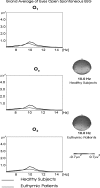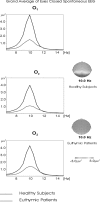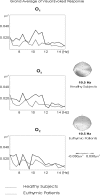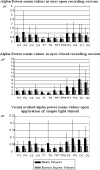Brain's alpha activity is highly reduced in euthymic bipolar disorder patients
- PMID: 23372616
- PMCID: PMC3253163
- DOI: 10.1007/s11571-011-9172-y
Brain's alpha activity is highly reduced in euthymic bipolar disorder patients
Abstract
Brain's alpha activity and alpha responses belong to major electrical signals that are related to sensory/cognitive signal processing. The present study aims to analyze the spontaneous alpha activity and visual evoked alpha response in drug free euthymic bipolar patients. Eighteen DSM-IV euthymic bipolar patients (bipolar I n = 15, bipolar II n = 3) and 18 healthy controls were enrolled in the study. Patients needed to be euthymic at least for 4 weeks and psychotrop free for at least 2 weeks. Spontaneous EEG (4 min eyes closed, 4 min eyes open) and evoked alpha response upon application of simple visual stimuli were analyzed. EEG was recorded at 30 positions. The digital FFT-based power spectrum analysis was performed for spontaneous eyes closed and eyes open conditions and the response power spectrum was also analyzed for simple visual stimuli. In the analysis of spontaneous EEG, the ANOVA on alpha responses revealed significant results for groups (F(1,34) = 8.703; P < 0.007). Post-hoc comparisons showed that spontaneous EEG alpha power of healthy subjects was significantly higher than the spontaneous EEG alpha power of euthymic patients. Furthermore, visual evoked alpha power of healthy subjects was significantly higher than visual evoked alpha power of euthymic patients (F(1,34) = 4.981; P < 0.04). Decreased alpha activity in spontaneous EEG is an important pathological EEG finding in euthymic bipolar patients. Together with an evident decrease in evoked alpha responses, the findings may lead to a new pathway in search of biological correlates of cognitive impairment in bipolar disorder.
Keywords: Bipolar disorder; EEG alpha activity; Euthymia; Schizophrenia; Visual evoked alpha oscillations.
Figures




References
-
- Aydemir Ö, Deveci A (2003) Validity and reliability of structured inter view for Hamilton depression rating scale seasonal affective disorders. Annual Spring Symposium of Psychiatric Association of abstract book, pp 187
-
- Babiloni C, Binetti G, Cassarino A, Dal Forno G, Del Percio C, Ferreri F, Ferri R, Frisoni G, Galderisi S, Hirata K, Lanuzza B, Miniussi C, Mucci A, Nobili F, Rodriguez G, Romani GL, Rossini PM. Sources of cortical rhythms in adults during physiological aging: a multi-centric EEG study. Human Brain Mapp. 2006;27:162–172. doi: 10.1002/hbm.20175. - DOI - PMC - PubMed
-
- Babiloni C, Cassetta E, Binetti G, Tombini M, Del Percio C, Ferreri F, Ferri R, Frisoni G, Lanuzza B, Nobili F, Parisi L, Rodriguez G, Frigerio L, Gurzì M, Prestia A, Vernieri F, Eusebi F, Rossini PM. Resting EEG sources correlate with attentional span in mild cognitive impairment and Alzheimer’s disease. Eur J Neurosci. 2007;25:3742–3757. doi: 10.1111/j.1460-9568.2007.05601.x. - DOI - PubMed
LinkOut - more resources
Full Text Sources

